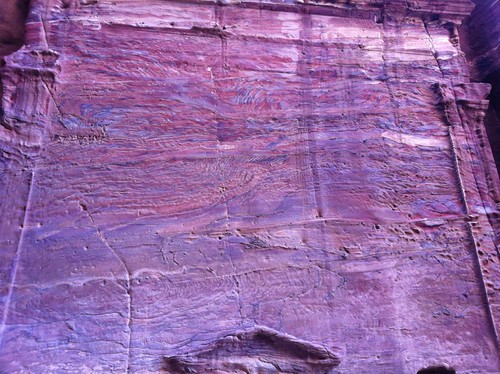When sand dunes sit for a long time, the sand at the very bottom of the dune slowly becomes rock–sandstone. Like other kind of sedimentary rock (rock which forms by dirt and stuff piling on and on and on over centuries and millennia) the oldest rock is at the bottom and the youngest at the top. See, you can find the curves of a sand dune here:

But, unlike other common forms of sedimentary rock like limestone (which can be found on many coasts), sandstone tends to have stunning waves because sand dunes move so fast. This may seem counterintuitive, since we don’t usually think of sand dunes as racers, but compared to the relatively sedentary sea floor, they scurry like cats at a restaurant.

When the wind shifts directions and moves a sand dune over, or makes it flatter or taller, or sand of a different chemical composition filters down to the bottom, the rock will show these stripes. Each curve and wiggle reflects a change in wind–not over a day or a week, not because of a nor’easter or even El Nino, but a shift centuries in the making. See the vein of a different color smiling through?

But one of the greatest beauties of sandstone isn’t its thin lines, showing repeated moments in history when something darker and thicker covered the dunes than their normal sand. Its the way different waves of dunes slipped up, against, and around each other:


It looks like what would happen if you flash-froze the arches of waves on the beach, one after another. Like a flipbook, if you squint you can see the movement of a dune over a millennia.
Inspirational Quote:
“Perhaps I shall not write my account of the Paleolithic at all, but make a film of it. A silent film at that, in which I shall show you first the great slumbering rocks of the Cambrian period, and move from those to the mountains of Wales…from Ordovician to Devonian, on the lush glowing Cotswolds, on to the white cliffs of Dover… An impressionistic, dreaming film, in which the folded rocks arise and flower and grow and become Salisbury Cathedral and York Minster…”― Penelope Lively, Moon Tiger
Wonderful series on Jordan’s rocks – Thanks!
Jessica,
Marvelous! Please keep them coming. Oh, and Malvina Reynolds – “Tiny Boxes”. Love her songs.
Jim
Very beautiful! I hope you keep all your photos and comments!
It is very beautiful, Jessica, but I think you’ve mistaken what the colours represent at Petra.
The colour banding runs through the sedimentary banding, is superimposed upon it and is therefore younger than the sandstone itself. I guess it’s the result of the movement of iron-rich minerals in ground water once the sandstone has formed. I suspect that Thomas Paradise would be able to give you more precise details: http://geosciences.uark.edu/138.php
This is certainly not to detract from the beauty of the rocks – or your enthusiasm for them!